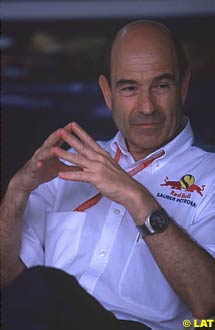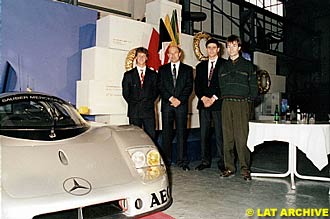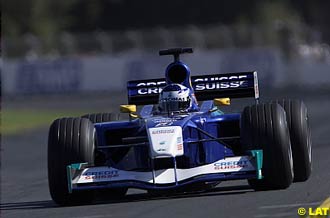You have to hand it to Peter Sauber: he's still with it in a big way after more than 30 years in the sport.
 Sauber built his own cars since taking up motorsports in 1967, at the age of 24. He started with a club-racing special based on a Volkswagen Beetle platform and progressed through space-framed cars to a Cosworth BDG-engined monocoque spyder in 1975, the C4. The following year his company, P.P. Sauber AG of Hinwil near Zurich, became a racing car constructor. It produced customer replicas of its BMW-engined C5 sports-racer for international Group 6 competition.
Sauber built his own cars since taking up motorsports in 1967, at the age of 24. He started with a club-racing special based on a Volkswagen Beetle platform and progressed through space-framed cars to a Cosworth BDG-engined monocoque spyder in 1975, the C4. The following year his company, P.P. Sauber AG of Hinwil near Zurich, became a racing car constructor. It produced customer replicas of its BMW-engined C5 sports-racer for international Group 6 competition.
In 1977 and 1978, Sauber's C5 spyder was seen at Le Mans, each year leading the 2.0-litre Group 6 class prior to its retirement. In 1980, Sauber ran a BMW M1 in the Procar championship. In the following year he constructed a pair of space-frame M1 lookalikes for Group 5, or 'Silhouette' racing. One of these, entered by GS Tuning, won the Nurburgring 1,000-kilometre race in the hands of Hans Stuck and Nelson Piquet.
In 1982, new FISA regulations swept aside Groups 5 and 6 for both international sports car racing and for the important German sports-racing championship. Intrigued by the puzzle posed by the new Group C fuel-consumption rules, a cadre of Daimler-Benz designers got together to see how it might be solved. Among the engineers in the entirely unofficial group were Leo Ress, Rolf Holzapfel and Wolfgang Muller. Aerodynamicist Rudiger Faul provided an overall concept and the living-room table on which their Group C design took shape. Helmut Julicher drew up the monocoque chassis. The engine was to be the Mercedes-Benz M117 V-8.
How were they to build such a car? Without money and a place to make it, it was only a pleasant fantasy. In August 1981, however, Rudiger Faul received a phone call from Swiss composite-materials specialists Seger & Hoffmann. "We are making a Group C car for 1982," came the Swiss-German accent, "and we need an aerodynamicist." Faul's name had been suggested by the department of aerodynamics at the Stuttgart University. His answer was easy: "We have a design all ready!"
 Thus the first 'Concept by Mercedes-Benz' racing car became the SHS (Seger & Hoffmann/Sauber) C6. In its final form it inherited uprights and some other parts from the Sauber M1 project but was otherwise a clean-sheet-of-paper project based on the designs made in Stuttgart. P. P. Sauber AG built its aluminium monocoque chassis as a subcontractor to Seger & Hoffmann, which moulded advanced composites into the sleek body with its high-placed rear wing and finished the complete cars.
Thus the first 'Concept by Mercedes-Benz' racing car became the SHS (Seger & Hoffmann/Sauber) C6. In its final form it inherited uprights and some other parts from the Sauber M1 project but was otherwise a clean-sheet-of-paper project based on the designs made in Stuttgart. P. P. Sauber AG built its aluminium monocoque chassis as a subcontractor to Seger & Hoffmann, which moulded advanced composites into the sleek body with its high-placed rear wing and finished the complete cars.
They adapted the C6 to the 3.95-litre DFL V-8 engine developed by Cosworth for Ford in anticipation of the new category. A large-bore, long-stroke version of its famous DFV Grand Prix V-8, Ford's DFL betrayed the confidence that Sauber placed in it. The Group C fuel allocation proved to be too generous for the DFL. Even driven flat-out it couldn't consume the full race ration. Worse, the secondary imbalance inherent in running a large 90-degree V-8 with a flat-plane crankshaft at high rpm was severe. Ress recalled that even the bulkheads in the Sauber tub cracked: "The car shook so much that it was impossible to drive."
Peter Sauber looked again to the familiar 3.5-litre BMW straight-six from the M1. Offering around 450 bhp compared to over 600 bhp for the Porsche 956, the BMW unit was woefully short of power but it promised reliable performance at a modest cost. Cost was important because the disappointments of 1982 led to a bitter and unpleasant parting of the ways between former partners Sauber and Seger & Hoffmann. Money was being spent on lawyers instead of racing cars.
Helmut Julicher and Leo Ress, who had computer-modelled the suspension of the C6 with the support of his colleagues and computers at Mercedes-Benz research, cooperated on the design of a new sheet-aluminium chassis frame for the BMW-engined C7. It had to be completely different from the C6, whose design elements were tied up in litigation. Then in the process of moving from Mercedes-Benz to BMW, bachelor Ress could take time off to work for Sauber on the new car. Leo Ress ultimately moved to Sauber to become his chief designer.
 Without a sponsor there was no money for real development of the new Sauber. The BMW-C7 turned at up at Le Mans in 1983 without the benefit of serious testing. Nevertheless, the slippery car was well suited to the high-speed circuit and proved reliable. In spite of its power deficit it finished a commendable ninth overall, interrupting a possible clean sweep of the top ten by Porsche.
Without a sponsor there was no money for real development of the new Sauber. The BMW-C7 turned at up at Le Mans in 1983 without the benefit of serious testing. Nevertheless, the slippery car was well suited to the high-speed circuit and proved reliable. In spite of its power deficit it finished a commendable ninth overall, interrupting a possible clean sweep of the top ten by Porsche.
For two years thereafter Peter Sauber lacked the finances to return to the sports-car wars. Yet in 1983 he had built and raced a car designed by an enthusiastic team of Mercedes-Benz engineers, working in a flat they had set up as a design office. Was Mercedes-Benz the answer for motors, for money, or for both?
The first official contact between Daimler-Benz and Sauber took place at the latter's Hinwil facility on October 28th 1983. Rudiger Faul took care of the introductions: Hermann Hiereth and Gert Withalm were among the Stuttgart group. Peter Sauber showed them around the shop and introduced them to his 11-strong staff. Most were servicing ordinary road cars; Sauber himself, with a helper, built the racing cars.
It was not taken for granted that their first joint project would be for Group C, in the full glare of a curious European press. Sauber had sold the BMW-powered C7 to an American team competing in the IMSA sports-prototype series. Two replicas were built to customer order with Chevrolet V-8 propulsion, also for IMSA GTP competition. Sauber knew the American scene; would that be a safer place to chance their arm initially?
They discussed the idea of a 3.5-litre V-8 with a single turbocharger to power an IMSA-series contender to test their componentry far away from Europe's inquisitive press before attempting Group C. But the latter goal proved the most attractive. The formula's fuel limit was appealing. "It was obvious that Group C development had the same aim as our work: a high specific output with low weight and low fuel consumption," said Hiereth.
Mercedes-Benz would not be seen to be supplying built-up engines to Sauber. The participation would be presented in an ultra-low-key manner. Publicly, Mercedes-Benz would be portrayed as selling the necessary high-performance parts to Heini Mader, who in turn would undertake the preparation of the race engines for Sauber as he had previously.
Thus was created the relationship between Sauber and Daimler-Benz that led to the creation of the Sauber-Mercedes C9 and C11, silver cars that won 16 of the 18 races they contested in 1989 and 1990, including Le Mans in the former year. The alliance between Stuttgart and Hinwil led in 1991 to the idea of a Formula One car carrying the three-pointed star. Sauber was anointed as the project contractor, and he in turn engaged Ilmor Engineering to build a suitable V-10 engine. The first Formula One Sauber, the C12 designed by Harvey Postlethwaite, took to the tracks in 1993.
In its first-ever race, a Sauber driven by J J Lehto finished fifth, thus collecting championship points. Eight years later history has repeated itself. In the first race of 2001 a Sauber has finished fifth, this time driven by Nick Heidfeld, and another has placed seventh, just outside the points. (The two would hours later be promoted to fourth and sixe, respectively.) The difference could be significant: in 1991 Sauber had a fast car, but didn't know why it was so fast. In 2001 there is every chance that the team knows its cars much better, and thus will be capable of developing them during the season.
I have to add a caveat to that. The new C20 Sauber was the work of Sergio Rinland, who has left the team. His successor is Stephen Taylor, who has joined from McLaren after 14 years in F1 with teams that included Lotus and Larrousse. He works under technical director Willi Rampf, who has been with Sauber since 1994. These are the men charged with the further development that the C20 will need if it is to keep pace with the progress of the front-runners during 2001. I think they can achieve it, given adequate resources.
Those resources have had a big boost this year. The arrival of Credit Suisse as a sponsor has been big news in Switzerland. For the first time a major Swiss institution has decided to back the country's motorsports leader. This could constitute a breakthrough that will encourage other Swiss firms to join in, especially after such a good start to the season.
Real achievement is at last within Peter Sauber's grasp. In German 'sauber' means 'clean'; Peter has run a clean team and deserves support. But is he serious about challenging for the top? We will know that he is if, quite soon, he announces that he is setting up a test team and appointing an experienced racer as test driver. Only with such a commitment will Sauber be able to carry out the development that will be needed to capitalize on a great start to the new season. It's time, Peter, to cut to the chase!

